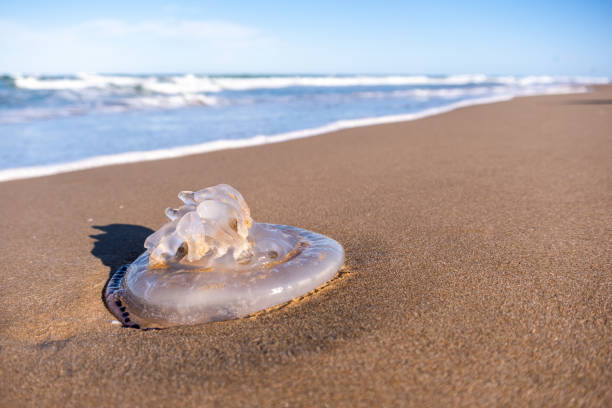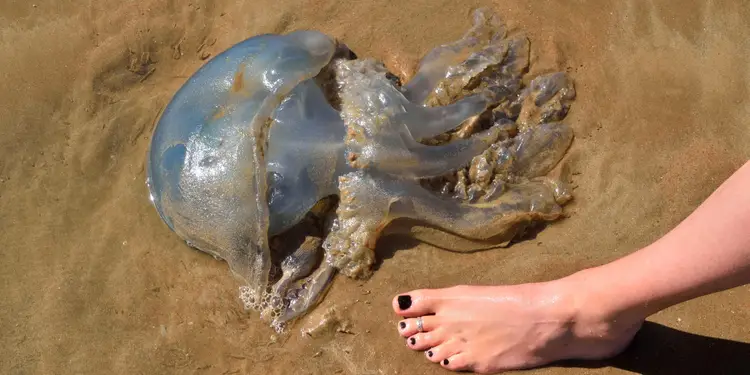With its stunning white sand beaches along the Panhandle, Pensacola attracts swimmers, snorkelers, and beach lovers year-round. But those planning water activities often wonder if jellyfish will be present to interfere with the fun.
While over 40 species of jellyfish inhabit the Gulf of Mexico, only some regularly appear along Pensacola’s shores. In this article, we’ll discuss what types of jellies are found near Pensacola, their sting potential, when they are most prevalent, conditions that affect them, and how to identify them.
Understanding basic jellyfish biology and patterns can allow enjoyment of Pensacola’s spectacular beaches while also avoiding encounters with the few species that can ruin your beach day. Let’s cover everything you need to know about jellyfish around Pensacola.

Common Jellyfish Species in Pensacola’s Coastal Waters
Here are the primary jellyfish that call the Northern Gulf home and may make periodic appearances along Pensacola Beach:
- Moon Jellyfish – Clear translucent jellyfish with a mild sting. Moon jellyfish are very common both near shore and offshore.
- Atlantic Sea Nettle – Larger yellowish jelly with long tentacles and severe sting. Atlantic Sea Nettle Jellyfish are less numerous than moon jellies.
- Cannonball Jellyfish – Dense round jellyfish that don’t sting. Cannonball Jellyfish are often seen washed up on the sand.
- Mushroom Cap Jellyfish – White mushroom-shaped jelly related to moon jelly but with shorter tentacles. Moderate sting.
- Purple Sailor – Bluish-purple color with red and yellow hues. Mild to moderate sting potential.
The moon jelly and sea nettle account for most jellyfish found near Pensacola beaches at various times, especially in summer.

When Are Jellyfish Most Prevalent in Pensacola?
Jellyfish populations tend to spike during the warmer months from roughly April through October near Pensacola. However, a number of factors affect periods of high jellyfish activity:
- Spawning cycles – Jellyfish reproduce more during spring and summer leading to blooms of young jellies by mid-summer.
- Water temperature – Warmer water encourages jellyfish reproduction and optimal metabolism. Most jellyfish tolerate 50-90°F water.
- Prey availability – More prey like zooplankton available in warmer months sustains jellyfish blooms.
- Currents – Sustained onshore currents push offshore jellyfish populations toward beaches.
- Salinity – Most jellyfish cannot tolerate extended freshwater exposure. Heavy rains push them offshore.
- Weather – Storm winds and currents affect jellyfish movement. Calm seas allow jellyfish to remain closer to shore.
While seen year-round, most jellyfish in Pensacola appear near swimming areas during warmer months, especially June through August.
Where Are Jellies Commonly Found near Pensacola?
Jellyfish inhabit the entire water column but are most problematic in certain zones:
- Surf Zone – Onshore winds and waves accumulate jellyfish in the breaking surf area, increasing stings.
- Nearshore waters – Mild offshore winds push floating jellies toward the beach and swimmers.
- Passes and inlets – Currents funnel jellyfish from the Gulf into locations like Pensacola Pass.
- Floating offshore – Huge deep water jellyfish populations remain far offshore most of the time.
- Stranded on shore – Large numbers of dead jellies may wash up on the sand after storms or extenuating conditions.
While present offshore, onshore winds and currents pose the biggest jellyfish risk by transporting them near populated swimming beaches.
How Often Do Jellyfish Stings Occur?
While common offshore, most days pass with few or no jellyfish stings occurring on Pensacola Beach:
- Lifeguards log jellyfish stings by beach. Most guarded beaches log under 100 stings in an entire summer.
- Strong onshore winds result in more jellyfish and more stings over a few day period.
- Thousands of swimmers may be in the water with few issues on days jellies remain offshore.
- Severe stings needing medical treatment are very rare compared to total beach visitors.
- Sea lice, tiny crustaceans with a nasty sting, cause over 10 times more stings than jellyfish in Pensacola annually.
Pensacola jellyfish generally remain far enough offshore not to interfere with nearshore activities. While they occur, most people swimming or beachgoing will never encounter them.
How Dangerous Are Their Stings?
If you do get stung by a jellyfish near Pensacola, the level of severity depends on the species:
- Moon jellyfish – Have short mild stinging cells that cause minor localized skin irritation for 15-20 minutes. More an annoyance than anything.
- Atlantic sea nettles – Long tentacles covered in extremely potent stinging cells induce immediate severe pain that can radiate up a limb along with red, burning welts lasting over an hour. Requires first aid.
- Mushroom cap jellyfish – Moderately painful stings with possible skin rash and irritation lasting 30-45 minutes. Less dangerous than sea nettles.
- Purple sailor – Mild to moderately painful stings similar to moon jellies but covering more skin surface area.
Sea nettles pose the most serious sting risk due to their large size, extensive tentacles, and highly venomous cells. Still, significant stings are relatively uncommon with proper precautions.
Identifying and Avoiding Jellyfish Near Pensacola
Learning what to look for allows recognizing and steering clear of jellyfish near Pensacola:
- Watch for translucent floating blobs – Most jellyfish float visibly at the surface, appearing like clear plastic bags. Moon jellies are the most frequent.
- Look for dangling tentacles – Medium to long hair-like tendrils hanging down identify jellyfish like sea nettles with bad stings.
- Scan water before entering – Check for jellyfish in your immediate vicinity, especially murky water that obscures hazards.
- Keep distance from jellyfish – Try not to swim directly over or through known jellyfish. Avoid touching washed up ones.
- Exit water if large numbers appear – Leave the water if jellyfish populations bloom rapidly due to winds or currents.
- Consider protective clothing – Wearing pantyhose or sting-proof wetsuits reduces stings in known jelly zones.
By being aware and giving jellyfish adequate space, beachgoers can still safely enjoy Pensacola’s beaches.

First Aid for Jellyfish Stings
If stung by a jellyfish near Pensacola, here are some first-aid guidelines:
Paying attention to daily conditions, being able to identify jellyfish from a distance, and carefully avoiding them allows beachgoers to safely partake in Pensacola’s beautiful waters. Don’t let sparse jellyfish activity prevent fully experiencing this stunning section of Northwest Florida coastline! With due caution around known hazards, Pensacola offers world-class beaches waiting to be cherished.
- Do not rub or excessively touch the sting, as this can make it worse by spreading venom. Carefully rinse the area with saltwater to remove tentacles or residue.
- For mild stings, apply a paste of baking soda and water and take over-the-counter pain medication as needed.
- For moderate stings causing significant continued pain, pour vinegar over the area to deactivate remaining stinging cells and prevent further venom release.
- Severe allergic reactions involving breathing issues, muscle cramps, or widespread redness may require emergency medical treatment. Seek help immediately.
- Avoid reexposing sting to seawater, which can reactivate stingers.
- Jellyfish stings will hurt for 1-2 hours but ultimately cause no permanent damage in most cases. Alert lifeguards to any hazards.
With proper first aid, jellyfish stings can be treated as minor nuisances, allowing enjoyment of Pensacola’s spectacular beaches.

Frequently Asked Questions About Jellyfish in Pensacola
What is the most dangerous local jellyfish species?
The Atlantic sea nettle jellyfish poses the most hazardous sting danger due to its large size, extensive tentacles, and highly venomous sting that causes severe pain lasting over an hour.
When are jellyfish most numerous in Pensacola?
Jellyfish numbers increase close to shore during the warmer months from roughly April to October, with peak populations in the summer when sea temperatures are warmest. However, blooms can occur year-round during periods of onshore winds.
Where are jellyfish commonly spotted near Pensacola?
Jellyfish concentrate near the water’s surface anywhere from immediately offshore up to several miles out. Strong winds push them into the wave zone. They also accumulate near inlets and passes like Pensacola Pass.
How can I avoid jellyfish stings near Pensacola?
Look before wading into unclear water and give jellyfish ample space. Avoid directly swimming through known blooms. Consider protective clothing like pantyhose in areas with frequent jellyfish.
How should I treat a jellyfish sting near Pensacola?
Carefully remove clinging tentacles, rinse the sting with saltwater, apply vinegar or baking soda paste to prevent further venom release, take oral pain relievers, and monitor for severe allergic reactions.
What beaches near Pensacola have the most jellyfish?
Some areas tend to see more recurring jellyfish depending on factors like currents and winds, such as Casino Beach, Park East, Park West, and around the Pass. Numbers vary daily based on conditions though.
How long do jellyfish stings hurt for?
Most mild stings cause localized pain for 15-20 minutes. Moderate stings result in sharper pain, red marks, and skin irritation lasting up to an hour. Severe stings can cause pain lasting over two hours.
Can jellyfish go through my beach umbrella?
No, a beach umbrella provides an effective barrier against jellyfish tentacles or bodies. However, avoid touching jellyfish washed up onto the shore, as they can still sting.
How do I check for Pensacola beach jellyfish forecasts?
Ask lifeguards on duty about recent jellyfish activity, avoid swimming if numerous stings reported. Monitor Pensacola Beach flag warning system and local beach condition reports online for jellyfish hazard advisories.
Conclusion
Pensacola’s proximity to the Gulf of Mexico means jellyfish will be occasional visitors near its renowned beaches. While prevalent offshore, on most days few are present in swimming areas barring major winds or currents.

